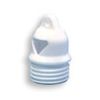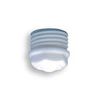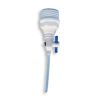Geotech 1" FEP Reusable Bailers
Features
- Available with a complete set of mix-and-match interchangeable components
- Ideal in all groundwater sampling applications
- Increased versatility with point source tops and controlled flow bottoms
- Expedited repair and warranty service
- Lifetime technical support
- More
These reusable water sampling bailers are made of chemically inert, 100% virgin fluoropolymer resin. Bailers are available with a complete set of mix and match interchangeable components making them ideal in all groundwater sampling applications.
- Standard Top: The opening is V notched for accurate pouring. The rounded thread design allows easy, complete cleaning.
- Bailer Body: The standard body is 1 3/4" and is available in 1 ft., 2 ft. and 3 ft. lengths. Bailers are also available in 3/4" and 1" O.D. for use in 1", 1 3/4" or 1 " diameter wells.
- Standard Bottom: Precision ground check valve stays confined to the bottom section to prevent loss. Special seat design prevents leakage and premature opening when emptying.
- Increased Versatility: The Point Sampling top offers an added check valve that isolates samples taken at specific depths. The Controlled Flow Bottom controls the flow rate from slow drip to rapid empty. High speed Sample Transfer Devices are available in several configurations.
In The News
Combating Water Insecurity in Saskatchewan with Real-Time Data
The prairies of Saskatchewan can be described as one of the least water-secure parts of Canada, making water quality monitoring essential for informed resource management in a region already facing water insecurity. While natural physical properties worsen some of the poor water quality conditions in the region, others are connected to land use. Having grown up spending summers on the shores of Lake Huron, Helen Baulch, an associate professor at the School of Environment and Sustainability at the University of Saskatchewan , has always been dedicated to the protection of water resources. Looking back fondly at her childhood playing along the shore, Baulch also recalls the invasion of quagga mussels during her teenage years and watching the lake change as a result.
Read MoreSeametrics Turbo Turbidity Logger: Boost your Turbidity Monitoring
The Seametrics Turbo Turbidity Logger is a self-cleaning turbidity sensor capable of internally logging over 260,000 data records. The sensor enables researchers, compliance officers, and contractors to monitor turbidity in various applications, from construction and dredging sites to wastewater effluent. Due to its narrow width, this device can be deployed in a range of areas, from small well spaces to rivers and streams. The stainless steel housing and built-in wiper allow the sensor to withstand long-term deployments and reduce the need for maintenance trips. The logger accurately records temperature and turbidity up to a depth of 50 meters.
Read MoreCollecting Data at the Top of the World: How Scientists Retrieve Glacial Ice Cores
A helicopter touches down in the small town of Sicuani, Peru, at an elevation of 11,644 feet. Earlier that day, a boxcar brought fuel, drills, food, and other equipment for a glacial expedition. The year is 1979, and glaciologist Lonnie Thompson is preparing to lead a team to the Quelccaya ice cap in hopes of becoming the first scientists to drill an ice core sample from this glacier. The only problem? The glacier is located at 19,000 feet in one of the most remote areas of the world. The helicopter takes off from the town, but the thin atmosphere at that elevation does not allow it to safely touch down on the ice– due to the aircraft’s weight, and it becomes unstable when the air is less dense.
Read More





















